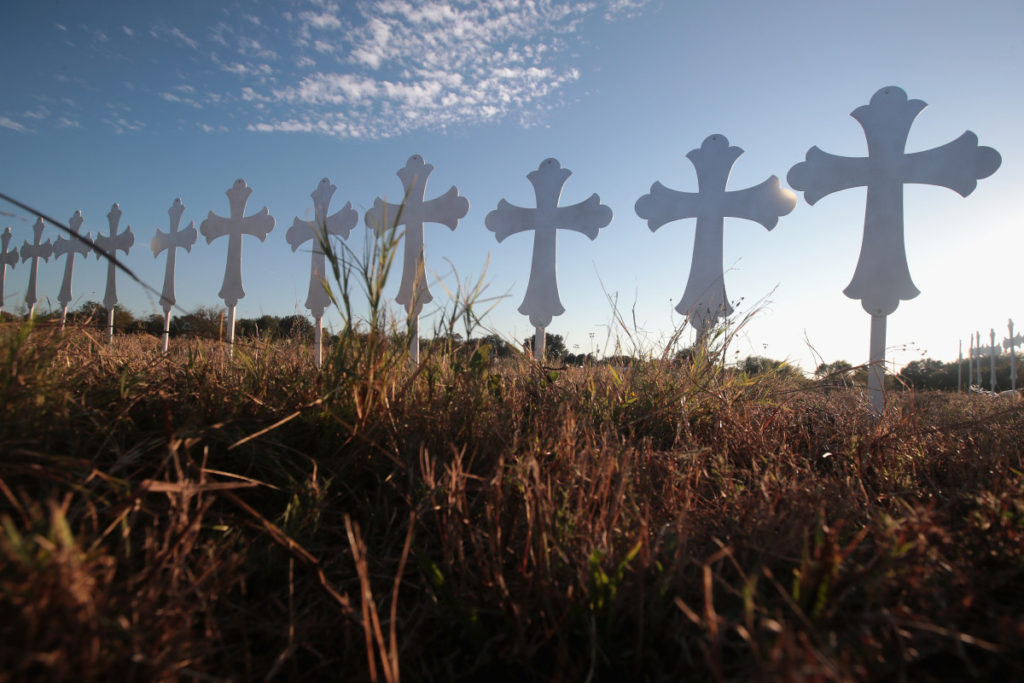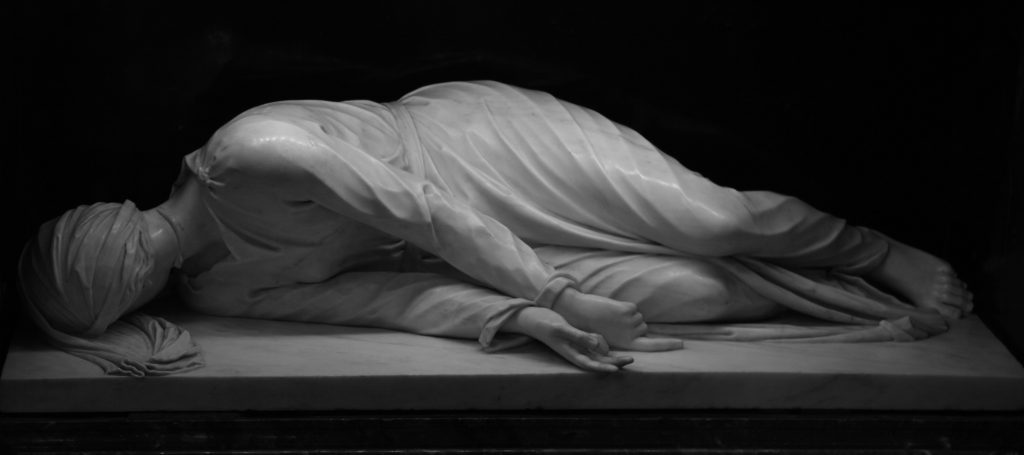The Patient Body
Unearned Positions
“The Patient Body” is a monthly column by Ann Neumann about issues at the intersection of religion and medicine. In this final installment: Misogyny and mass killings.
“I will utter things which have been kept secret from the foundation of the world” — Matthew 13:35 and the epigraph to Jordan Peterson’s 1999 book Maps of Meaning: The Architecture of Belief
On Friday, May 18 a 17 year old walked into his high school in Southeast Texas with a shotgun and a .38 revolver. He shot at least ten people dead, including his ex-girlfriend.
In April, a young man in Toronto drove his van into a crowd, killing ten people and wounding fourteen. Most of the dead were women, and the driver has been connected to an ideology that demeans women as less than human and advocates for forced sex as the right of males. The killer took his inspiration from another killer who shot and stabbed six people to death in Isla Vista, California, in 2014. Yet another young man killed twenty-six parishioners at First Baptist Church in Sutherland Springs, Texas last year. The killer wanted revenge on a spurning lover.
Easy gun access and a welling radicalization of disaffected and hate-filled young men is not a new phenomenon—but school shootings are. They are also a phenomenon with a strong foundation in U.S. culture.
When I began this column in October, 2013, the purpose was clear: to draw attention to the quote-unquote religious views weaponized (for political, social and plain old discriminatory reasons) to thwart by any means possible the full access and provision of health care to all Americans. Or the reverse: the use of medical science to confront and demean religious beliefs. (I’ve likely been more successful at the former than the latter.) With some few exceptions, this column has focused on the U.S. simply because of the research I was working on and the endless examples of where friction exists between religion and medicine.
The issues have been inexhaustible, from women’s reproductive rights to elders’ access to end of life care, from organ donation to drug regulation. The column has covered a wide range of issues—but continues, perhaps because of my own proclivities as much as the ongoing U.S. culture wars—to tend toward the subject of both overt and covert violence against women.
When this column began, some of us could blissfully take comfort in that old and noble saw, the arc of justice bending upwards. And then, of course, came President Trump and the license he gave to hatred, discrimination, and misogyny. It’s always been there, seething beneath our social fabric. But the mainstreaming of retrograde and gratuitous ideas that reinforce our spiral into violence against minority groups and women has had direct and horrifying results. What death and violence this mainstreaming has brought is supported by a growing and popular host of pseudo-intellectuals, lawmakers, and tastemakers who are willing to justify it. If there is an arc of justice, our current moment is left out of its long average.
Being a woman in the United States is dangerous to your health. Women have always been profoundly harmed by sexual violence at a greater rate than men, their bodies too long considered their rights and property. Coverture, the status of a married woman and all her possessions as the property of her husband, was common law for centuries. It is derived from the “legal fiction” that a man and wife were one entity: the husband. But the consideration of women’s bodies as the property of men didn’t end with coverture. As recently as seven years ago it was reported that a Virginia legislator, Dick Black, said that marital rape shouldn’t be a crime. In fact, marital rape wasn’t a crime until 1979.
Women’s sexuality has been used to justify white male violence for most of the nation’s history. The post-Civil War South employed ideas of (white) female sexual purity, national purity, and safety to justify slavery, lynchings, and white male violence. Even economic vitality was considered the reward for women’s sexual purity. As Ellen Ann Fentress recently wrote at The Baffler (where I’m web editor):
The myth of the threat of the black male rapist gave the white male an enhanced role as the necessary protector of white women and Southern society. He had a responsibility to make the community safe. An added plus was that the rape-threat claim was possibly the sole premise for deflection of Northern and British censure as the white South reestablished its power.
This violent history and treatment of women as male property has visceral ramifications for women today. Every minute, twenty people experience sexual violence, a vast majority of them women according to the National Coalition Against Domestic Violence. One in five women have been raped. One in three women have been a victim of some form of violence. One in seven have been stalked. One hundred and forty two women were killed at work by an abuser between the years of 2003 and 2008. When you intersect this data with race, poverty, maternity, education, language barriers, and fear of deportation, the prevalence of violence is compounded.
But what is becoming clear in the endless horror that is our regular news cycle is that misogyny, defined by philosopher Kate Manne as “social systems or environments where women face hostility and hatred because they’re women in a man’s world — a historical patriarchy,” is a defining factor in these mass killings. They are most often committed by young white men who are compelled to punish women for challenging male dominance, men who feel they are vulnerable to women’s challenges. As Jared Keller writes (citing the work of sociologist Michael Kimmel), a “complicated tension between homophobia and the developing masculinity of adolescent American men” characterized school shootings in the country between 1982 and 2001. This male, he writes, is a “clinical category.”

Crosses stand in a field on the edge of town to honor the 26 victims killed at the First Baptist Church on November 6th, 2017, in Sutherland Springs, Texas.
(Photo: Scott Olson/Getty Images)
There have been twenty-two school shootings since the beginning of 2018, for an average of more than one every week. After the May 18 shooting in Texas, Mark Allan Bovair posted on Twitter “The destabilization of the sexual marketplace has hit young men hard and any [attempt] to discuss the issue is labeled misogyny.” To men like this, female company and sex are considered a commodity that men are being cheated out of as women push for greater equality in society.
This subculture of male resentment has no shortage of adherents—and a new scion, Jordan Peterson, has recently achieved market saturation with the publication of a book that provides a pseudo-scientific, -intellectual, and -religious justification for anger among men and violence against women.
In a Nellie Bowles’ profile of Peterson in the New York Times, he encapsulated his ideology about the erosion of historical sexual norms and the inherent rights of men in a reference to the Toronto killer, saying, “He was angry at God because women were rejecting him. The cure for that is enforced monogamy. That’s actually why monogamy emerges.”
The modern world, according to Peterson, is rife not just with gun violence but also its cause, social and cultural chaos. Traditional family structures have been upended, genders are no longer binary, freedom of speech is increasingly restricted, identity politics are marring governance and social order, the old hierarchies have been dismantled, and ethics has strayed from the ancient moral teachings of the Bible. “The masculine spirit is under assault. It’s obvious,” Peterson further explained to the Times.
Peterson, a clinical psychologist at the University of Toronto and a mega-best selling author, has a solution to this “chaos”: return to earlier times when women knew their place, teach young men to toughen up, violently restore the patriarchy, and things will settle down. Peterson’s worldview is clearly popular. His quotes are internet-clogging memes. Videos of his talks on YouTube have millions of views. His adherents wear T-shirts with lobsters on them, lobsters being Peterson’s impossible-to-follow “scientific” proof that hierarchies are very, very old and therefore good. He’s selling out five thousand seat auditoriums and has amassed a devoted and noted following. Malcolm Gladwell has hailed him as a brilliant psychologist. At the New York Times, columnist David Brooks has called him the new William F. Buckley, Jr. and Ross Douthat parroted Peterson-like ideas in a recent column that argued for “the redistribution of sex” as “entirely responsive to the logic of late-modern sexual life,” by which he means a time in which women have a tenuous enough equality to choose who to have sex with.
A combination of particular characteristics makes Peterson attractive to nostalgics in search of a great thinker. According to Nathan J. Robinson at Current Affairs, “Peterson appears very profound and has convinced many people to take him seriously. Yet he has almost nothing of value to say.” He’s vague and hard to follow but his work contains shreds of inherent truth. He’s commanding, somber and over-the-top confident. And he brooks no challenge; a class-A Alphamale doesn’t.
Lord knows the right needs a new intellectual foundation. And that’s precisely why Peterson appeals to adherents of a mythologized past, young men who can’t get laid, anti-feminists, nationalists, the religion-y folk who see the world in a hand basket, conservatives too eager to exercise their brutal “might makes right” cosmology.
Celebrated as a great mind that must be heeded, praised, believed, Peterson has found an audience in search of, not so much a new message, but a brazen, white, credentialed, aggressive male authority who will widely evangelize an old message: male dominance by any means necessary. Peterson’s popularity as an elite mind coarsely splays the right on its own anti-intellectual petard. As journalist Josh Marshall wrote in a series of tweets after Bowles’ Times profile of Peterson was published:
She captures in the lede the role as validator, all those things you felt were true. You were right all along. I’ve actually become fascinated by these Peterson types and their role in the backlash against gender equality in this case but other MAGAist revanchist in other cases. They place themselves as something akin to the bodhisattvas of inceldom, men who have achieved transcendence or alphadom but are so filled with compassion for incels trapped in the illusion of modernity and sexual liberation that they have remained behind to …help usher these rage filled virgins toward gorilla mindset enlightenment.
A smart man, after all, is the man one agrees with. In addition to a misogyny-sympathetic narrative and the posturing of an intellectual man’s man, Peterson employs various other tools of the authenticity-generating variety: science, history, and religion. “I’m a scientist but I’m also a religious person, I’m a deeply religious person,” Peterson has stated, “Genuine religious truth tells you how to act.” In this age-old construction, religion (however vaguely defined in Peterson’s case) helps justify violence toward others as a means of obtaining and maintaining an ordered, hierarchical and peaceful society. The sanctity and purity of the nation requires white men to define, police, and “protect” female sexuality. Physically and violently enforced monogamy is then the best means of maintaining a pure and ordered nation.
Peterson’s ideas, as Bowles writes, “stem from a gnawing anxiety around gender.” Despite speaking, teaching and writing in relative obscurity for decades, he burst on the media scene in 2016 by loudly opposing a Canadian bill that made it possible for students to use their preferred pronouns. Peterson claimed that the gender-neutral pronouns violated his academic freedom and free speech. In a video viewed by more than 3 million people, Peterson is shown engaging with transgendered young students. As recounted in an article by Tom Bartlett for The Chronicle of Higher Education, when one student asks Peterson what gives him “the authority to determine which pronouns he uses when referring to someone else,” Peterson angrily responds, “Why do I have the authority to determine what I say? What kind of question is that?” (A man shot and killed nearly 50 people at a gay nightclub in Orlando, Florida that same year.)
Such arguments, which assert the unquestionable rights of a privileged and exclusive subset of the population over others—and insist that this dominance is historically, scientifically, legally and religiously justifiable—are the parlance of the moment.
As well, these arguments, by Peterson and others, are made by a demographic of American society that fears the end of longstanding violent, nativist, and misogynist norms and laws that have kept them on top to the detriment of others. This movement has turned rights and freedoms language on its head, applying them to a narrowing subset of society. Our president is, after all, an admitted sexual aggressor, hell bent on demeaning, dehumanizing, torturing and deporting those he finds socially, sexually or economically expendable. He is abetted by a coterie of officials, leaders, and voters who are drunk on their own control and eager for violent opportunities to “defend” it. Women and particularly women of color continue to pay the price of their health, independence and lives for this drunken orgy of political male dominance.
This is a culture war and the young white men with weapons are the crusading heroes. Peterson’s endorsement of violence is proving to empower and radicalize followers who are armed and out to take revenge on the health and safety of the rest of us, particularly autonomous women.
School is out now. We can pray for a quiet season, after the year’s record number of shootings. As midterm elections approach and the country reassesses its losses, women have focused their attention on running for office, on uncovering sexual harassment, on becoming activists against deportations and human rights abuses. “To everything there is a season and a time to every purpose under heaven.” I close out this long run of columns with muted hope, but with a great deal of satisfaction in the subjects its many installments have allowed me to explore with you.
***
Ann Neumann is author of The Good Death: An Exploration of Dying in America (Beacon, 2016) and a visiting scholar at The Center for Religion and Media, NYU.
***
This is the final installment of Ann Neumann’s column, “The Patient Body,” which began in October 2013 and has appeared in almost every issue of The Revealer since. It has been an enormous pleasure to work with Ann each month — her insights and analysis have been vital to our work and we will miss her and them. But don’t fret, you can still see Ann’s wit and verve in full force over at The Baffler where she is now Web Editor. And if you’ve missed an installment of “The Patient Body” we invite you to check out the full archive, here. — Kali Handelman, Editor
***
Published with support from the Henry R. Luce Initiative on Religion in International Affairs.

